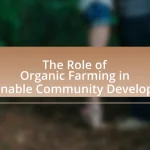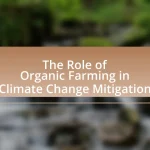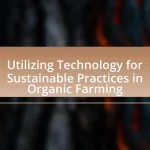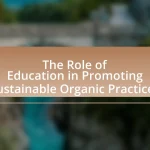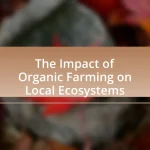Creating a sustainable fertilizer plan for organic crops is essential for enhancing soil health and minimizing environmental impact. This article outlines the components of such a plan, including the use of natural amendments like compost and organic fertilizers, and emphasizes the importance of sustainability in maintaining soil fertility and promoting biodiversity. Key principles of sustainable agriculture, strategies for nutrient management, and the role of soil testing are discussed, along with the benefits of practices like crop rotation and cover cropping. Additionally, the article addresses challenges faced by organic farmers and provides best practices for effective fertilizer planning and compliance with organic certification requirements.

What is a Sustainable Fertilizer Plan for Organic Crops?
A sustainable fertilizer plan for organic crops involves the use of natural amendments and practices that enhance soil health while minimizing environmental impact. This plan typically includes the application of compost, green manures, and organic fertilizers such as bone meal or fish emulsion, which provide essential nutrients without synthetic chemicals. Research indicates that organic farming practices can improve soil structure and biodiversity, leading to increased crop resilience and productivity. For instance, a study published in the journal “Agriculture, Ecosystems & Environment” found that organic farming systems can enhance soil organic matter and microbial activity, which are crucial for sustainable crop production.
Why is sustainability important in fertilizer planning for organic crops?
Sustainability is crucial in fertilizer planning for organic crops because it ensures the long-term health of ecosystems and soil fertility. Sustainable practices, such as using organic fertilizers, reduce chemical runoff and promote biodiversity, which enhances soil structure and nutrient availability. Research indicates that organic farming can improve soil organic matter by 20-30% over time, leading to better water retention and reduced erosion. Additionally, sustainable fertilizer planning aligns with consumer demand for environmentally friendly products, as 70% of consumers prefer organic options due to perceived health and environmental benefits.
What are the key principles of sustainable agriculture?
The key principles of sustainable agriculture include maintaining soil health, conserving water, promoting biodiversity, and reducing chemical inputs. Maintaining soil health involves practices such as crop rotation and cover cropping, which enhance soil structure and fertility. Conserving water is achieved through efficient irrigation techniques and rainwater harvesting, ensuring that water resources are used judiciously. Promoting biodiversity involves cultivating a variety of crops and integrating livestock, which can enhance ecosystem resilience. Reducing chemical inputs focuses on minimizing the use of synthetic fertilizers and pesticides, thereby lowering environmental impact and promoting ecological balance. These principles are supported by research indicating that sustainable practices can lead to increased productivity and environmental health over time.
How does sustainability impact soil health and crop yield?
Sustainability positively impacts soil health and crop yield by promoting practices that enhance soil structure, fertility, and biodiversity. Sustainable agricultural practices, such as crop rotation, cover cropping, and reduced chemical inputs, improve soil organic matter and microbial activity, which are crucial for nutrient availability and soil resilience. Research indicates that sustainable practices can increase crop yields by 20-30% compared to conventional methods, as evidenced by a study published in the journal “Nature Sustainability,” which found that sustainable farming systems significantly enhance soil health and productivity over time.
What are the main components of a sustainable fertilizer plan?
The main components of a sustainable fertilizer plan include nutrient management, soil health enhancement, and environmental protection. Nutrient management involves the careful selection and application of fertilizers to meet crop needs while minimizing excess. Soil health enhancement focuses on practices that improve soil structure, organic matter, and microbial activity, which can be achieved through the use of compost, cover crops, and crop rotation. Environmental protection ensures that fertilizer use does not lead to water pollution or greenhouse gas emissions, often guided by regulations and best management practices. These components collectively contribute to the sustainability of agricultural practices, promoting long-term productivity and ecological balance.
What types of organic fertilizers are available?
There are several types of organic fertilizers available, including compost, manure, bone meal, blood meal, fish emulsion, and seaweed extract. Compost is made from decomposed organic matter and enriches soil with nutrients and beneficial microorganisms. Manure, sourced from livestock, provides essential nutrients and improves soil structure. Bone meal is a slow-release phosphorus source, while blood meal is high in nitrogen, promoting plant growth. Fish emulsion offers a balanced nutrient profile and is easily absorbed by plants. Seaweed extract contains trace minerals and growth hormones that enhance plant health. These organic fertilizers contribute to sustainable agriculture by improving soil fertility and promoting healthy crop growth.
How do nutrient requirements differ among various organic crops?
Nutrient requirements differ among various organic crops primarily due to their specific growth stages, types of crops, and soil conditions. For instance, leafy greens like spinach require higher nitrogen levels for optimal growth, while root vegetables such as carrots benefit from increased potassium and phosphorus to enhance root development. Additionally, legumes, which fix nitrogen in the soil, have lower nitrogen needs compared to non-leguminous crops. Research indicates that different crops also have varying responses to organic fertilizers; for example, tomatoes thrive with balanced nutrient inputs, while cucumbers may require more calcium to prevent blossom end rot. These differences necessitate tailored fertilization strategies to meet the unique nutrient profiles of each crop, ensuring sustainable growth and yield.
How can farmers assess their soil health for fertilizer planning?
Farmers can assess their soil health for fertilizer planning by conducting soil tests that analyze nutrient levels, pH, organic matter content, and microbial activity. Soil testing provides quantitative data that helps farmers understand the specific nutrient needs of their crops, enabling them to apply fertilizers more effectively. Research indicates that regular soil testing can improve crop yields by 10-20% by ensuring that nutrient applications are tailored to the actual needs of the soil and plants.
What soil tests should be conducted to determine nutrient levels?
To determine nutrient levels in soil, essential tests include a soil pH test, a macronutrient test for nitrogen, phosphorus, and potassium, and a micronutrient test for elements like iron, manganese, and zinc. The soil pH test assesses acidity or alkalinity, which influences nutrient availability. The macronutrient test quantifies the primary nutrients necessary for plant growth, while the micronutrient test identifies trace elements that are crucial in smaller amounts. Conducting these tests provides a comprehensive understanding of soil fertility, enabling the formulation of an effective fertilizer plan tailored to organic crops.
How can soil amendments improve fertility in organic farming?
Soil amendments can significantly improve fertility in organic farming by enhancing soil structure, increasing nutrient availability, and promoting beneficial microbial activity. For instance, organic matter from compost or green manure improves soil aeration and water retention, which facilitates root growth and nutrient uptake. Additionally, amendments like bone meal or rock phosphate provide essential nutrients such as phosphorus, which is crucial for plant development. Research indicates that incorporating organic amendments can lead to a 20-30% increase in crop yields compared to untreated soils, demonstrating their effectiveness in enhancing soil fertility.

What strategies can be employed to create an effective sustainable fertilizer plan?
To create an effective sustainable fertilizer plan, implement strategies such as soil testing, crop rotation, and the use of organic amendments. Soil testing identifies nutrient deficiencies and pH levels, allowing for tailored fertilizer applications that meet specific crop needs. Crop rotation enhances soil health and reduces pest and disease cycles, which can minimize the need for synthetic fertilizers. Additionally, incorporating organic amendments like compost or green manure enriches soil fertility and promotes microbial activity, contributing to long-term sustainability. Research indicates that these practices can improve soil structure and nutrient availability, leading to healthier crops and reduced environmental impact.
How can crop rotation enhance soil fertility?
Crop rotation enhances soil fertility by improving nutrient availability and reducing soil degradation. Different crops have varying nutrient requirements and root structures, which can lead to a more balanced nutrient profile in the soil. For example, legumes, such as beans and peas, fix nitrogen in the soil, enriching it for subsequent crops. Research indicates that implementing crop rotation can increase soil organic matter by 10-20%, which is crucial for maintaining soil health and fertility. Additionally, rotating crops can disrupt pest and disease cycles, further contributing to healthier soil ecosystems.
What are the benefits of incorporating cover crops?
Incorporating cover crops provides multiple benefits, including improved soil health, enhanced nutrient cycling, and reduced erosion. Cover crops, such as clover and rye, contribute organic matter to the soil, which increases microbial activity and nutrient availability. Research indicates that cover crops can reduce nitrogen leaching by up to 50%, thereby improving water quality and reducing the need for synthetic fertilizers. Additionally, they help prevent soil erosion by stabilizing the soil with their root systems, which can decrease soil loss by as much as 90% in some cases. These benefits collectively support sustainable agricultural practices and contribute to a more resilient farming system.
How does intercropping contribute to nutrient management?
Intercropping contributes to nutrient management by enhancing soil fertility through the complementary use of different plant species. This practice allows for the efficient use of nutrients, as different crops can utilize various soil layers and nutrient types, reducing competition and promoting a balanced nutrient uptake. For instance, legumes in intercropping systems can fix atmospheric nitrogen, enriching the soil for subsequent crops, which is supported by studies showing that intercropping can increase nitrogen availability by up to 30% compared to monoculture systems. Additionally, diverse root structures improve soil structure and microbial activity, further contributing to nutrient cycling and availability.
What role do compost and manure play in sustainable fertilization?
Compost and manure are essential components of sustainable fertilization as they enhance soil fertility, improve soil structure, and promote microbial activity. Compost, made from decomposed organic matter, enriches the soil with nutrients and beneficial microorganisms, while manure provides a rich source of nitrogen, phosphorus, and potassium. Studies show that using compost can increase crop yields by up to 30% compared to conventional fertilizers, and manure application can improve soil organic matter content, leading to better water retention and reduced erosion. These practices contribute to a closed nutrient cycle, reducing the need for synthetic fertilizers and minimizing environmental impact.
How can composting be effectively implemented on a farm?
Composting can be effectively implemented on a farm by establishing a systematic process that includes collecting organic waste, maintaining proper carbon-to-nitrogen ratios, and regularly turning the compost pile. Farmers should gather materials such as crop residues, animal manure, and kitchen scraps, ensuring a balanced mix of green (nitrogen-rich) and brown (carbon-rich) materials to facilitate decomposition. The ideal carbon-to-nitrogen ratio is approximately 30:1, which promotes microbial activity essential for breaking down organic matter. Regularly turning the compost pile every few weeks aerates the material, speeds up the decomposition process, and helps maintain optimal moisture levels. Research indicates that well-managed composting can reduce waste by up to 50% and improve soil health, enhancing crop yields and sustainability on farms.
What are the best practices for using manure as fertilizer?
The best practices for using manure as fertilizer include proper composting, application timing, and appropriate rates. Composting manure reduces pathogens and stabilizes nutrients, making it safer and more effective for crops. Applying manure in the fall or early spring allows for nutrient absorption before planting, while adhering to recommended application rates prevents nutrient runoff and environmental contamination. Research indicates that properly managed manure can enhance soil fertility and structure, supporting sustainable agricultural practices.
How can farmers monitor and adjust their fertilizer plans over time?
Farmers can monitor and adjust their fertilizer plans over time by utilizing soil testing, crop monitoring, and data analysis. Soil testing provides baseline nutrient levels, allowing farmers to tailor their fertilizer applications based on specific crop needs and soil conditions. Regular crop monitoring, including visual assessments and yield data collection, helps farmers identify nutrient deficiencies or excesses during the growing season. Additionally, employing precision agriculture technologies, such as GPS and remote sensing, enables farmers to analyze data effectively, leading to informed adjustments in fertilizer applications. Research indicates that implementing these practices can enhance nutrient use efficiency and improve crop yields, supporting sustainable farming practices.
What indicators should be tracked to evaluate fertilizer effectiveness?
To evaluate fertilizer effectiveness, key indicators include crop yield, nutrient uptake, soil health, and environmental impact. Crop yield measures the quantity of produce harvested, which directly reflects the fertilizer’s contribution to plant growth. Nutrient uptake assesses how well plants absorb essential nutrients from the fertilizer, indicating its efficiency. Soil health indicators, such as organic matter content and microbial activity, provide insights into the long-term effects of fertilizer on soil quality. Lastly, environmental impact metrics, including runoff and leaching of nutrients, help determine the sustainability of fertilizer use. Tracking these indicators ensures a comprehensive evaluation of fertilizer effectiveness in organic crop production.
How can farmers adapt their plans based on changing conditions?
Farmers can adapt their plans based on changing conditions by implementing flexible crop rotation strategies and utilizing real-time data for soil health and weather patterns. For instance, adjusting planting schedules and selecting crop varieties that are more resilient to climate variability can enhance productivity. Research indicates that farmers who employ precision agriculture techniques, which include monitoring soil moisture and nutrient levels, can optimize fertilizer use and reduce waste, leading to more sustainable practices. Additionally, integrating cover crops can improve soil structure and fertility, allowing farmers to respond effectively to environmental changes.

What challenges might arise in creating a sustainable fertilizer plan?
Creating a sustainable fertilizer plan may face challenges such as nutrient availability, cost-effectiveness, and environmental impact. Nutrient availability can be limited due to the reliance on organic sources, which may not provide all essential nutrients in adequate amounts. Cost-effectiveness is another challenge, as organic fertilizers often have higher production and application costs compared to synthetic alternatives, potentially discouraging adoption among farmers. Additionally, the environmental impact of sourcing organic materials, such as deforestation for biomass or over-extraction of natural resources, can undermine sustainability goals. These challenges necessitate careful planning and innovative solutions to ensure the effectiveness and sustainability of fertilizer use in organic crop production.
What are the common obstacles faced by organic farmers?
Organic farmers commonly face obstacles such as pest management, soil fertility, and market access. Pest management is challenging due to the limited availability of organic pesticides, which can lead to crop losses. Soil fertility issues arise from the reliance on natural fertilizers, which may not provide the same nutrient levels as synthetic options, impacting crop yields. Additionally, organic farmers often struggle with market access, as they may face higher competition and lower prices compared to conventional farming, making it difficult to sustain profitability. These challenges are supported by research indicating that organic farming can yield 20-30% less than conventional methods due to these constraints, as noted in studies by the Organic Farming Research Foundation.
How can farmers overcome nutrient deficiencies in organic crops?
Farmers can overcome nutrient deficiencies in organic crops by implementing a combination of soil testing, crop rotation, and the use of organic fertilizers. Soil testing allows farmers to identify specific nutrient deficiencies and tailor their fertilization strategies accordingly. Crop rotation helps maintain soil health and nutrient balance by alternating crops that have different nutrient requirements. Additionally, organic fertilizers such as compost, manure, and cover crops enrich the soil with essential nutrients, promoting healthier crop growth. Research indicates that these practices not only enhance nutrient availability but also improve soil structure and microbial activity, leading to sustainable agricultural practices.
What strategies can mitigate the impact of pests and diseases?
Integrated Pest Management (IPM) is a key strategy to mitigate the impact of pests and diseases in organic crops. IPM combines biological control, habitat manipulation, and resistant crop varieties to reduce pest populations and disease incidence. For instance, introducing beneficial insects like ladybugs can naturally control aphid populations, while selecting disease-resistant crop varieties can significantly lower the risk of crop failure due to diseases. Research indicates that farms employing IPM practices can reduce pesticide use by up to 50% while maintaining crop yields, demonstrating its effectiveness in sustainable agriculture.
How can regulations and certifications affect fertilizer planning?
Regulations and certifications significantly influence fertilizer planning by establishing guidelines that ensure the use of safe and environmentally friendly practices. These regulations often dictate the types of fertilizers that can be used, their application rates, and timing, which directly impacts crop yield and soil health. For instance, the USDA Organic Certification requires that fertilizers used in organic farming must be derived from natural sources, limiting options for farmers and necessitating careful planning to comply with these standards. Additionally, adherence to regulations can affect market access; certified organic products often command higher prices, incentivizing farmers to align their fertilizer planning with these requirements to meet consumer demand and regulatory compliance.
What are the key organic certification requirements related to fertilizers?
Key organic certification requirements related to fertilizers include the prohibition of synthetic fertilizers and the necessity for fertilizers to be derived from natural sources. Organic fertilizers must comply with the National Organic Program (NOP) standards, which specify that materials used must be listed on the National List of Allowed and Prohibited Substances. Additionally, fertilizers must not contain genetically modified organisms (GMOs) and should be produced through processes that maintain their organic integrity. Compliance with these requirements ensures that fertilizers contribute to sustainable agricultural practices while adhering to organic farming principles.
How can farmers stay compliant with local agricultural regulations?
Farmers can stay compliant with local agricultural regulations by regularly reviewing and adhering to the specific guidelines set forth by local agricultural authorities. This includes understanding regulations related to fertilizer use, pesticide application, and crop management practices. For instance, many regions require farmers to maintain records of fertilizer applications and adhere to specific nutrient management plans to minimize environmental impact. Compliance can be further ensured by participating in training programs offered by agricultural extension services, which provide updates on regulatory changes and best practices.
What are some best practices for implementing a sustainable fertilizer plan?
Implementing a sustainable fertilizer plan involves using organic fertilizers, optimizing nutrient management, and integrating crop rotation. Organic fertilizers, such as compost and manure, improve soil health and reduce chemical runoff. Optimizing nutrient management includes soil testing to determine nutrient needs and applying fertilizers at the right time and in the right amounts, which minimizes waste and environmental impact. Crop rotation enhances soil fertility and disrupts pest cycles, leading to healthier crops. These practices are supported by research indicating that organic fertilizers can increase soil organic matter by 1-3% annually, improving overall soil structure and fertility.
How can farmers effectively educate themselves about sustainable practices?
Farmers can effectively educate themselves about sustainable practices by engaging in continuous learning through workshops, online courses, and agricultural extension services. These resources provide practical knowledge and up-to-date information on sustainable farming techniques, including soil health, crop rotation, and organic fertilization methods. Research indicates that farmers who participate in educational programs are more likely to adopt sustainable practices, as evidenced by a study published in the Journal of Sustainable Agriculture, which found that 70% of participants improved their farming methods after attending workshops. Additionally, networking with other farmers and joining local agricultural organizations can facilitate knowledge sharing and support the implementation of sustainable practices.
What resources are available for ongoing support and guidance?
Resources available for ongoing support and guidance in creating a sustainable fertilizer plan for organic crops include agricultural extension services, online platforms like ATTRA Sustainable Agriculture Program, and local organic farming associations. Agricultural extension services provide expert advice and research-based information tailored to local conditions, while ATTRA offers a wealth of resources, including publications and webinars focused on organic practices. Local organic farming associations often host workshops and networking events that facilitate knowledge sharing among farmers. These resources collectively support farmers in implementing effective and sustainable fertilization strategies.

